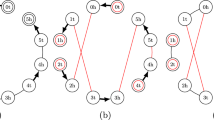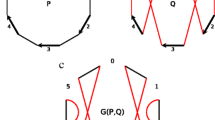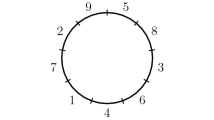Abstract
Genome rearrangements are evolutionary events that shuffle genomic architectures. Usually the rearrangement distance between two genomes is estimated as the minimal number of rearrangements needed to transform one genome into another, which is usually referred to as the parsimony assumption.
Since in reality the parsimony assumption may or may not hold, the question arises of estimating the true evolutionary distance (i.e., the actual number of genome rearrangements between the genomes of two species). While several methods for solving this problem have been developed, all of them have their own disadvantages. In the current paper we consider a very general model and provide a flexible estimator as well as the limits of applicability for the most popular estimation methods, such as the maximum parsimony method.
Access this chapter
Tax calculation will be finalised at checkout
Purchases are for personal use only
Similar content being viewed by others
Notes
- 1.
In the breakpoint graph constructed on synteny blocks of two genomes, there are no trivial cycles since no adjacency is shared by both genomes. However, the breakpoint graph constructed on orthologous genes or multi-genome synteny blocks may contain trivial cycles.
References
Alexeev, N., Alekseyev, M.A.: Estimation of the true evolutionary distance under the fragile breakage model. BMC Genomics 18(Suppl 4), 19–27 (2017)
Alexeev, N., Aidagulov, R., Alekseyev, M.A.: A computational method for the rate estimation of evolutionary transpositions. In: Ortuño, F., Rojas, I. (eds.) IWBBIO 2015. LNCS, vol. 9043, pp. 471–480. Springer, Cham (2015). https://doi.org/10.1007/978-3-319-16483-0_46
Alexeev, N., Avdeyev, P., Alekseyev, M.A.: Comparative genomics meets topology: a novel view on genome median and halving problems. BMC Bioinform. 17(14), 418 (2016)
Avdeyev, P., Alexeev, N., Rong, Y., Alekseyev, M.A.: A unified ILP framework for genome median, halving, and aliquoting problems under DCJ. In: Meidanis, J., Nakhleh, L. (eds.) RECOMB-CG 2017. LNCS, vol. 10562, pp. 156–178. Springer, Cham (2017). https://doi.org/10.1007/978-3-319-67979-2_9
Biller, P., Gueguen, L., Knibbe, C., Tannier, E.: Breaking good: accounting for fragility of genomic regions in rearrangement distance estimation. Genome Biol. Evol. 8(5), 1427–1439 (2016)
Braga, M.D.V., Willing, E., Stoye, J.: Genomic distance with DCJ and indels. In: Moulton, V., Singh, M. (eds.) WABI 2010. LNCS, vol. 6293, pp. 90–101. Springer, Heidelberg (2010). https://doi.org/10.1007/978-3-642-15294-8_8
Cayley, A.: A theorem on trees. Q. J. Math. 23, 376–378 (1889)
Compeau, P.E.C.: A simplified view of DCJ-indel distance. In: Raphael, B., Tang, J. (eds.) WABI 2012. LNCS, vol. 7534, pp. 365–377. Springer, Heidelberg (2012). https://doi.org/10.1007/978-3-642-33122-0_29
Compeau, P.E.C.: DCJ-Indel sorting revisited. Algorithms Mol. Biol. 8(1), 6 (2013)
El-Mabrouk, N.: Genome rearrangement by reversals and insertions/deletions of contiguous segments. In: Giancarlo, R., Sankoff, D. (eds.) CPM 2000. LNCS, vol. 1848, pp. 222–234. Springer, Heidelberg (2000). https://doi.org/10.1007/3-540-45123-4_20
Jung, S., Cestaro, A., Troggio, M., Main, D.: Whole genome comparisons of fragaria, prunus and malus reveal different modes of evolution between rosaceous subfamilies. BMC Genomics 13(129), 1–12 (2012)
Lin, Y., Moret, B.M.: Estimating true evolutionary distances under the DCJ model. Bioinformatics 24(13), i114–i122 (2008). https://doi.org/10.1093/bioinformatics/btn148
Ma, J., et al.: Reconstructing contiguous regions of an ancestral genome. Genome Res. 16(12), 1557–1565 (2006)
Nadeau, J.H., Taylor, B.A.: Lengths of chromosomal segments conserved since divergence of man and mouse. Proc. Natl. Acad. Sci. 81(3), 814–818 (1984). https://doi.org/10.1073/pnas.81.3.814
Ohno, S.: Evolution by Gene Duplication. Springer, Berlin (1970). https://doi.org/10.1007/978-3-642-86659-3
Pevzner, P.A., Tesler, G.: Human and mouse genomic sequences reveal extensive breakpoint reuse in mammalian evolution. Proc. Natl. Acad. Sci. 100, 7672–7677 (2003)
Shao, M., Lin, Y.: Approximating the edit distance for genomes with duplicate genes under DCJ, insertion and deletion. BMC Bioinform. 13, S13 (2012). BioMed Central
Shao, M., Lin, Y., Moret, B.: An exact algorithm to compute the DCJ distance for genomes with duplicate genes. In: Sharan, R. (ed.) RECOMB 2014. LNCS, vol. 8394, pp. 280–292. Springer, Cham (2014). https://doi.org/10.1007/978-3-319-05269-4_22
Swenson, K.M., Marron, M., Earnest-DeYoung, J.V., Moret, B.M.E.: Approximating the true evolutionary distance between two genomes. J. Exp. Algorithmics 12, 3–5 (2008)
The OEIS Foundation: The On-Line Encyclopedia of Integer Sequences (2018). http://oeis.org
Wang, L.S., Warnow, T.: Estimating true evolutionary distances between genomes. In: Proceedings of the Thirty-Third Annual ACM Symposium on Theory of Computing, pp. 637–646. ACM (2001)
Yancopoulos, S., Attie, O., Friedberg, R.: Efficient sorting of genomic permutations by translocation, inversion and block interchange. Bioinformatics 21(16), 3340–3346 (2005)
Yancopoulos, S., Friedberg, R.: Sorting genomes with insertions, deletions and duplications by DCJ. In: Nelson, C.E., Vialette, S. (eds.) RECOMB-CG 2008. LNCS, vol. 5267, pp. 170–183. Springer, Heidelberg (2008). https://doi.org/10.1007/978-3-540-87989-3_13
Acknowledgments
The authors thank Artem Vasilyev and Pavel Avdeyev for fruitful discussions and the anonymous reviewers for valuable comments.
The work of NA was financially supported by the Government of the Russian Federation through the ITMO Fellowship and Professorship Program. The work of AZ was financially supported by the Government of the Russian Federation (Grant 08-08).
Author information
Authors and Affiliations
Corresponding author
Editor information
Editors and Affiliations
Rights and permissions
Copyright information
© 2018 Springer Nature Switzerland AG
About this paper
Cite this paper
Zabelkin, A., Alexeev, N. (2018). Estimation of the True Evolutionary Distance Under the INFER Model. In: Blanchette, M., Ouangraoua, A. (eds) Comparative Genomics. RECOMB-CG 2018. Lecture Notes in Computer Science(), vol 11183. Springer, Cham. https://doi.org/10.1007/978-3-030-00834-5_4
Download citation
DOI: https://doi.org/10.1007/978-3-030-00834-5_4
Published:
Publisher Name: Springer, Cham
Print ISBN: 978-3-030-00833-8
Online ISBN: 978-3-030-00834-5
eBook Packages: Computer ScienceComputer Science (R0)




